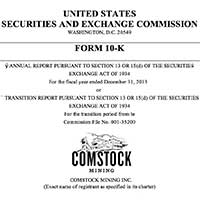
Before Comstock Mining Inc’s Annual Report for 2013 to the SEC was released last month, the company communicated with the public and with its shareholders on several occasions. These efforts seemed notable:
On February 11 CMI established a ‘revolving credit facility’ for $5 million, and the next day drew $4.6 million against it.
A few days later Corrado De Gasperis appeared on Sam Shad’s “Nevada Newsmakers” TV program.
Then CMI announced it was busily seeking new investors
And finally, during the regular conference call preceding the SEC filing, a determined stockholder pressed Corrado to say when the company would be in profit, and he said it would be in the second quarter of this year. At least I think that’s what he said; see what you think: So I think efficiency from mining and hauling when it comes to strip ratio and then improved throughput from grade really, really puts us to where we want to be in terms of profitability. So, when is that full all-in point, for everything I would say in the second quarter for sure.
In the annotation of Corrado’s interview with Sam Shad I mentioned that CMI had offered “No buyouts except at deeply discounted prices with a token downpayment and the balance in common stock.”
CMI’s 2013 10-K report to the SEC confirms this: “Subsequent to December 31, 2013 , the Company entered into an agreement to purchase 78 Acres in American Flat, Storey County, Nevada for $1,107,000 . The purchase price includes $10,000 cash and the remaining amount payable in restricted common stock.”
That’s a $1.1 million real estate deal, consummated with a $10,000 down-payment and a satchel full of mining stock certificates which must be held for six months before they can be sold.
Here’s another one: “Subsequent to December 31, 2013, the Company also entered into an agreement to purchase buildings and mining claims adjacent to its processing facility on American Flat Road, Storey County, Nevada for $893,000 . The purchase price includes $10,000 cash and the remaining amount payable in restricted common stock. Escrow is expected to close on or before February 25, 2015.”
Several other interesting statements appear in the document. Here’s one:
“On August 16, 2013, the Company received a “stop order” from the Nevada Division of Environmental Protection (NDEP) with respect to the use of certain crushing and transfer systems of the Company because emissions controls, although effective, were not deemed to be compliant with an applicable permit. The Company was able to remedy the controls and the stop order was lifted on August 23, 2013. The Company did not experience any material delays or work stoppages as a result of the stop order, and therefore revenues were not materially affected.
“As a follow up and in accordance with the Nevada Administrative Code, on September 6, 2013, NDEP requested that the Company submit certain information and documentation to NDEP to support NDEP’s determination as to the compliance of the Company’s facility with the conditions of the operating permit. The Company provided all such requested information and documentation on a timely basis in accordance with the request. On February 21, 2014, the Company received a final notice of violation associated with this investigation, indicating no air emission violations occurred; however, a final warning, with no further action required, was issued indicating the Company failed to install certain air pollution control equipment. In most cases, the Company had installed alternative, more effective air control equipment. The Company believes that it is in full compliance with its permits granted by NDEP.”
NDEP says this is not correct. “What I can tell you is that the information represented in the passage [above] is completely inaccurate and will be corrected by the company. In addition the NDEP-BAPC has not issued its final determination.” — Francisco Vega, NDEP Supervisor, Compliance & Enforcement, Bureau of Air Pollution Control”
Here’s another:
“From time to time, we are involved in lawsuits, claims, investigations and proceedings that arise in the ordinary course of business. There are no matters pending that we expect to have a material adverse impact on our business, results of operations, financial condition or cash flow.”
CMI is a party to the Lyon County District Court Complaint which seeks to reverse the Lyon County Commission decisions of January 2 and send the question of zone change and Master Plan amendment back to the Planning Commission. If CMI says that an adverse ruling in this case won’t have a material adverse impact on the company’s operations, you have to believe it; they’d be fools, or desperate, to include false information to the SEC (see above).
But the company doesn’t mind leaving things out:
“Corrado De Gasperis has been President and CEO of Comstock Mining since April 2010, and appointed to the Board of Directors in June 2011. He brings over 26 years of industrial metals and mining manufacturing, operational and financial management, and capital markets experience. Previously, he served as the Chief Executive Officer of Barzel Industries Inc. (formerly Novamerican Steel Inc.) from April 2006 through September 2009. Barzel operated a network of 15 manufacturing, processing and distribution facilities in the United States and Canada that offered a wide range of metal solutions to a variety of industries, including construction, infrastructure development and mining.”
Unmentioned here is the material fact that he bankrupted this thriving, productive company in just 20 months, costing some 400 employees their jobs. They are the ones who named him, unforgettably, Corrupto De Gasbag. This would be a black mark on his record unless he did it on purpose. Did he? I don’t know.
The company also states that the Gold Hill Hotel has 12 full-time employees and 5 part-time workers, making its nearly half a million dollar loss last year more understandable. The hotel has only 14 rooms, five of them “petite” to say the least, plus 6 cabins and guest houses across the street. I’m told the restaurant is quite good, and even better when Squeek is playing the piano, and that the bar, when it is full, is full of miners.
There are eight pages of Risk Factors in the report, beginning at the bottom of page 8. Risk Factors #2 (there are 32 altogether) and #20 seem especially apt. Number two says, “Because we may never earn significant revenues from our mine operations, our business may fail.” The question is, how long will the string of zeros get before it goes down. Number 20 is succinct: “We have no insurance for environmental problems.” That seems a glaring lack and a major gamble for an inexperienced company cutting expenses to the bone and churning up dust in a Mercury Superfund site that includes residential neighbors in two counties.
But perhaps the most revealing information in the report is the topic titled “Inventories, Stockpiles and Mineralized Materials on Leach Pads”. Here we are informed that the total went down from $4.2 mil to half a mil. This suggests that in 2014, the company has hardly any processed reserves to draw on, as they must have done in 2013, and are dependent on finding a continuing supply of high-value ore in order to maintain revenues. Observation of pit activity indicates more blasting, and the use of ore trucks to move dirt, not to the leach pad, but to other parts of the site, indicating it is overburden, and is being moved to reach the ore. Therefore, the prospect of the company doubling its revenues this year rates at best as unlikely, and Corrado’s prediction of 2014 profits, even by the 4th quarter, seem more than optimistic.














